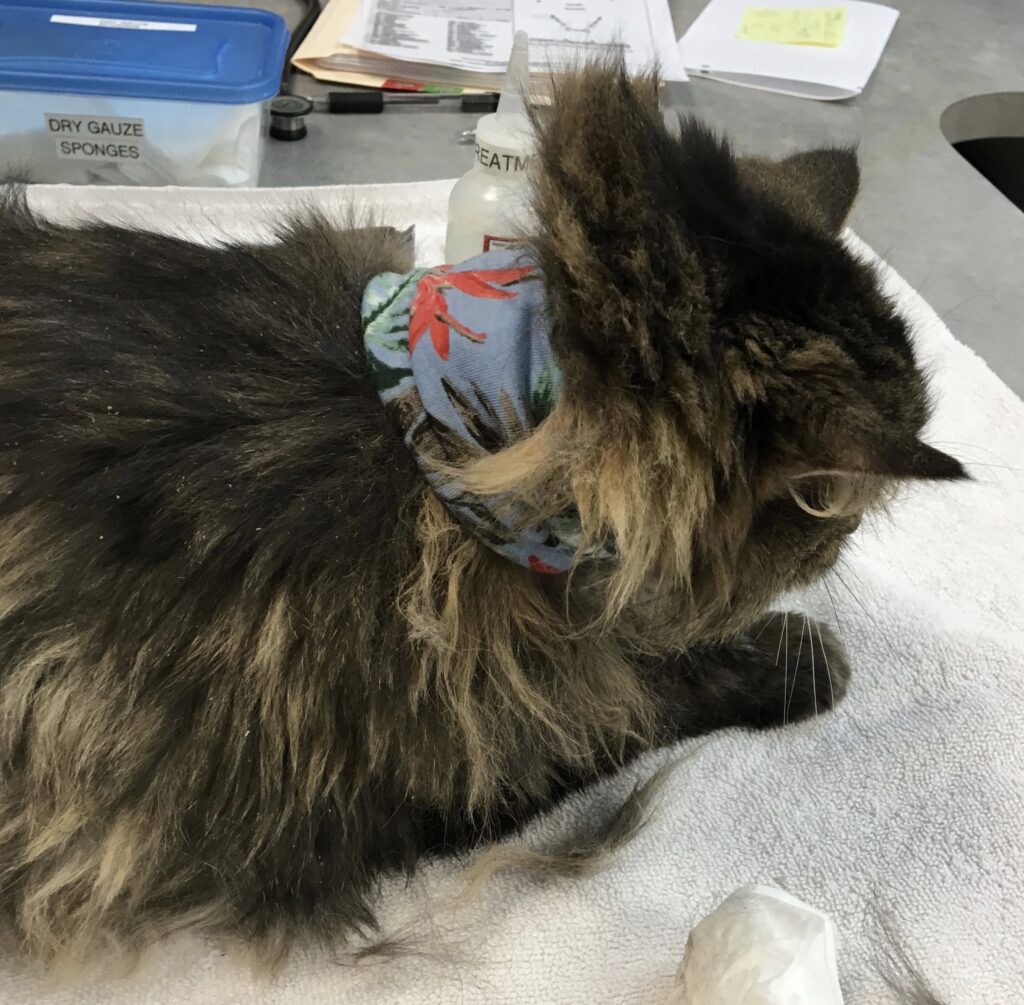
Managing the diabetic cat
Managing the diabetic cat is a balancing act. The goal is to reduce the clinical signs of diabetes while avoiding complications like low blood sugar.
How do you know if the therapy your veterinarian has chosen for your cat is working? Monitoring the clinical signs of diabetes is a start. (Reference 1). Pay attention to:
- Your cat’s attitude and activity level
- daily thirst and urination
- daily food intake
- weekly weight and body condition score
Your veterinarian will want to monitor your cat’s blood and urine regularly but these are “snapshots” (values at a particular time on a particular day). What is happening during a diabetic cat’s day?
monitoring Insulin-based therapies
Insulin-based diabetic therapies focus on the level of glucose in the blood.
- Blood sugar is highest before giving one of the twice daily injections of insulin.
- After giving insulin, the cells start to take up glucose and the level of glucose in the blood starts to drop
- Blood sugar levels out somewhere between the morning and evening doses and starts to increase as insulin wears off
- The lowest point in the plot is called the “nadir”; the high points in the morning and evening are called “peaks”
If you sample your diabetic cat’s blood every few hours and plot the blood glucose values on a graph, you will get a picture of how the insulin is working.
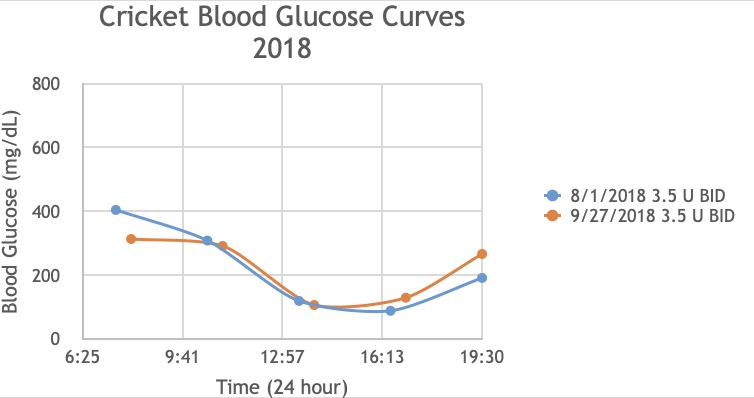
The Home Glucose Curve
Because cats are prone to stress hyperglycemia, it is best to measure these curves at home. This can be done using (1) a handheld meter and sampling every few hours or (2) a Continuous Glucose Monitoring system, consisting of an electronic sensor applied to the cat and a device to read the output of the sensor.
Blood Glucose Meter
These are like the meters used by human diabetics. Instead of pricking a fingertip, it is typical to prick the area around the vein that runs along the outside of the ear. The strip in the glucose meter soaks up the blood like a sponge and a current is generated. The strength of the signal is proportional to the blood sugar.
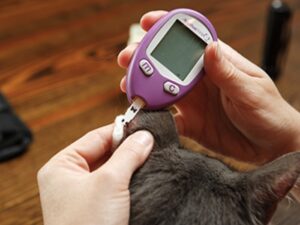
Continuous Glucose Monitoring System
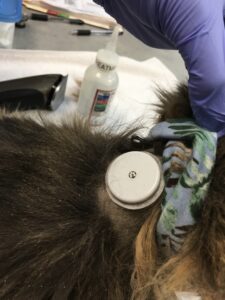
The Freestyle Libre is a continuous glucose monitoring system developed for humans that can be used with cats. The electronic sensor is the size of two stacked US quarters; the sensor can be scanned with a smartphone or dedicated reader device. The sensor samples every minute and stores data for 8 hours before starting to overwrite it. It is important to scan the sensor at least every 8 hours.
Sensor life can range from a few days to 2 weeks. The sensor can be placed on the back of the neck, behind the shoulder, or on the flank. A 2″ x 2″ area is clipped and cleaned for sensor application.
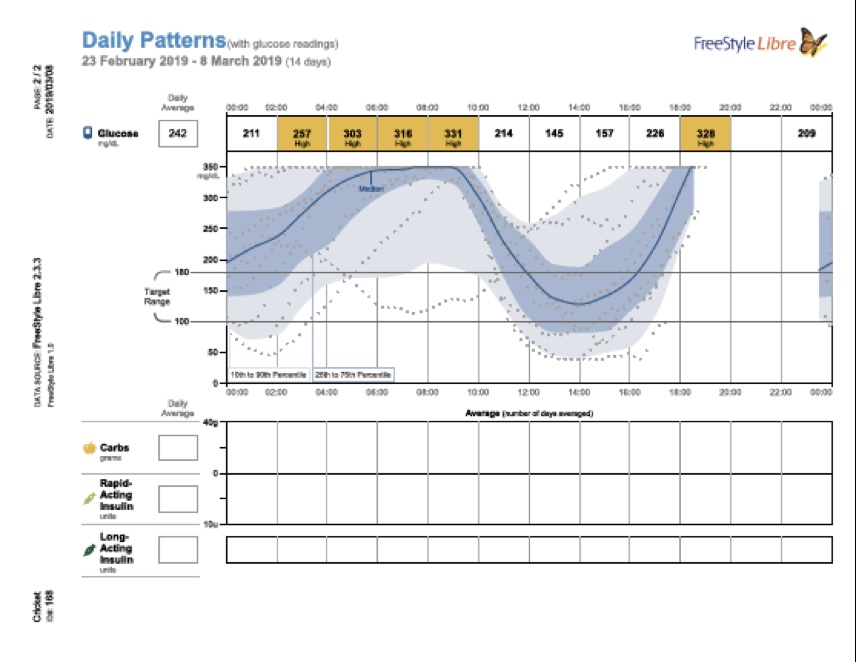
Monitoring glucose allows your veterinarian to adjust the insulin dose or change the type of insulin to best regulate your cat. The goals of insulin therapy are (Reference 1):
- Peak Glucose values of 180-250 mg/dL
- Nadir Glucose values of 80-144 mg/dL
managing the diabetic cat – emergencies
HYPOGLYCEMIA
Low blood sugar can be life threatening when blood glucose drops to < 40 mg/dL. You may notice your cat is tired, unresponsive, disoriented and anxious.
What triggers hypoglycemia in the managed feline diabetic?
- insulin dose is too high relative to food intake
- too much insulin is given
- your cat is in remission
If your cat’s glucose in the blood is normal, there is no glucose in the urine, and his fructosamine is in normal range, your veterinarian will start to gradually reduce the insulin dose until insulin is discontinued. If blood glucose values remain in the normal range and there is no glucose in the urine for 2- 4 weeks once insulin has been stopped, your cat is in remission!
If you suspect low blood sugar…
- measure blood glucose (BG)
- BG less than 80 mg/dL – feed the cat or give up to 1 tablespoon corn syrup by mouth (1 tbsp = 15 mls – you don’t need to give this all at once)
- recheck BG in 15 minutes
- if glucose rises, continue to offer food and check glucose until the value is in a normal range
- notify your veterinarian
- if your cat is unconscious, rub some syrup on his gums or inside his cheek, measure BG, and go the the ER!
DIABETIC KETOACIDOSIS
Diabetic cats have an abnormal glucose metabolism and their bodies may break down fats for energy, resulting in ketones in the bloodstream. Too high a level of ketones makes the blood acidic, causing cells to function abnormally. This is more likely to happen:
- in newly diagnosed diabetics and poorly regulated diabetics
- when there are illnesses such as infections, tumors, dental disease (Reference 2)
Watch for…
- Loss of appetite
- Lethargy and depression
- Vomiting/diarrhea
- dehydration
- difficulty breathing
- a sweet smell to the cat’s breath
This is a true emergency – high levels of ketones in the blood and urine combined with the blood and other body fluids becoming acidic can be fatal. Treatment starts with IV fluids to correct dehydration and electrolyte imbalances and administration of insulin to restore glucose as the main source of energy.
Managing the diabetic cat: non-insulin based therapies
Blood glucose curves are part of the recommended monitoring process for cats receiving oral non-insulin therapy but they do not have as important a role as monitoring a cat on insulin. Cats receiving the oral therapies are not prone to low blood sugar and the blood glucose curve will not have the characteristic shape of a cat receiving insulin. Glucose readings are simply averaged. It is more important to monitor ketones as these cats may be more prone to develop DKA.
Ketones can be monitored using “urine dipsticks”. The cat’s urine is collected using non-absorbent litter or a litter tray with a sieve bottom. Urine is collected with a syringe and dropped on the urine test strip (Reference 1). The makers of Senvelgo, a oral liquid non-insulin drug, recommend checking ketones this way every 1-3 days in the first 14 days of therapy.
Urine dipsticks detect acetoacetic acid and are not very sensitive. Hand-held meters that detect levels of beta-hydroxybutyrate in the blood provide a more sensitive measure of ketones. Blood can be collected from the ear vein of the cat and level of ketones measured similar to the blood glucose meters described above. Abott’s Precision Xtra meter has been validated for use in cats (Reference 3). Perhaps, as non-insulin therapies become more common, monitoring of ketones in the blood will become part of managing the diabetic cat at home.
With appropriate treatment, the diabetic cat can have a life expectancy similar to cats without diabetes. The key to managing the diabetic cat is early diagnosis, weight control, regular exams and labwork, and home monitoring of clinical signs, glucose and ketones.
references
- ISFM Consensus Guidelines on the Practical Management of Diabetes Mellitus in Cats. Sparkes, A. (chairman), Journal of Feline Medicine and Surgery (2015) 17, 235-250
- Rudloff E. Diabetic ketoacidosis in the cat: Recognition and essential treatment. Journal of Feline Medicine and Surgery. 2017;19(11):1167-1174. doi:10.1177/1098612X17735762
- Weingart C, Lotz F, Kohn B. Validation of a portable hand-held whole-blood ketone meter for use in cats. Vet Clin Pathol. 2012 Mar;41(1):114-8. doi: 10.1111/j.1939-165X.2011.00389.x. Epub 2012 Jan 17. PMID: 22250845.

